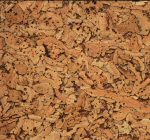Properties and characteristics of the main natural and ecological insulation.
This page is part of the file on natural insulation.
2) Cork
Pure expanded cork comes from the cork oak tree (ideally renewable material) which is exploited extensively in the Mediterranean basin.
It is part of the bark of this tree. It is a plant tissue formed of dead cells with suberified walls. It protects the living parts of the trunk and branches of the tree. Its harvest by "debarking", if it is done well, does not lead to the death of the oak! It is therefore an easily renewable material.

Cross-section of an Oak-Liege trunk (source)
Rot-proof, water-repellent, non-flammable, resistant to attacks by insects, rodents, fungi, it is one of the best sound and thermal insulators.
It may be packaged as sheets, plates, or bulk form of granules. It is very simple to implement for externally insulate walls, roofs.
Top notch econological: it may come from recycled cork.
The expanded cork chipboard panels

Rot-proof, lightweight, waterproof, rodent and compression resistant. It is sold in the form of sheets of different dimensions and thicknesses and can also be used for sound insulation of floors and walls. A surface coating can be directly applied (paint, crepissage, wallpaper, etc.).
The cork granules (bulk):

It is deposited in the same floor, in the attic or under a floor or a double wall and bound in a lime-cement concrete floors for light.
The cork tiles:

Easy to install, the cork slab replaces a floor, it is waterproof, flexible under the foot, silent and sound insulation much better than a floor.
To have already walked on cork slabs, I can assure you that the feeling is nice.
Can be used for the surface to a high traffic (entrances, hallways, bathrooms) or often sprayed with water (bathroom) or in children's rooms to replace the carpet.
Thermal properties:
- Thermal conductivity: 0,032 (chipboard) to 0,05 (slab) W / m ° C.
- Thermal resistance for a layer of 10 cm of aglomer: 0,1 / 0,032 = 3,125 m². ° C / W. In other words, one m2 of cork of 10cm will allow 0,32W (1 / 3,125) to pass per degree of temperature difference.
Cork chipboard is 0,4 / 0,32 1,25 = times better than glass wool. For the same insulation, reduced 25% of thickness is sufficient.
More: others natural insulation

